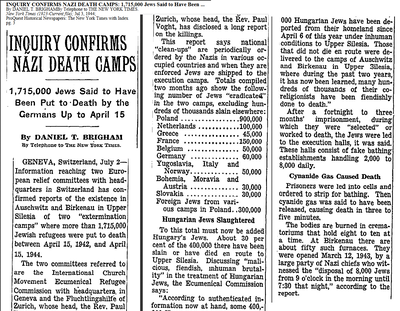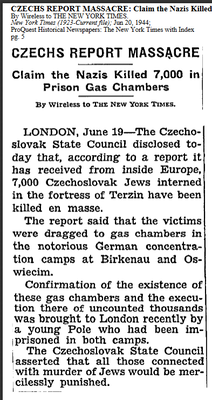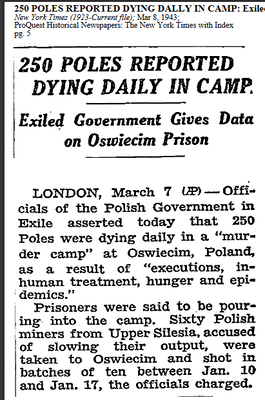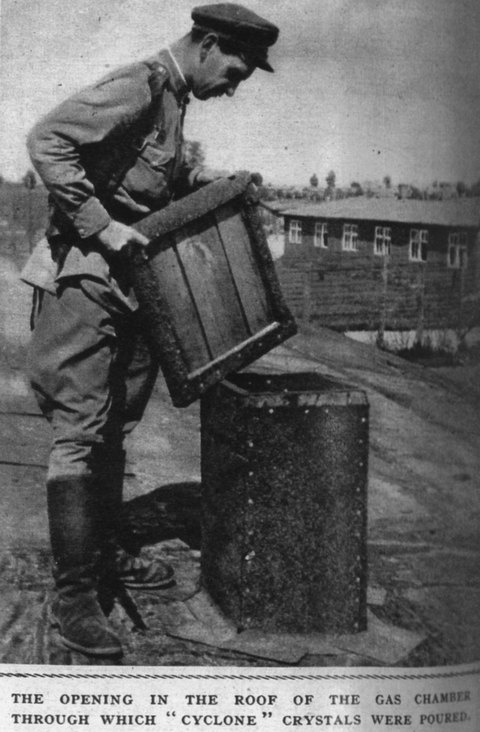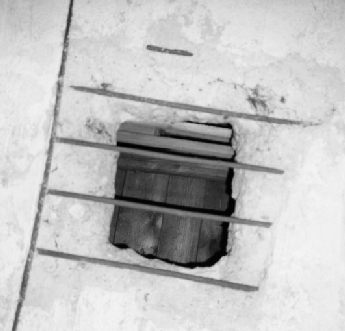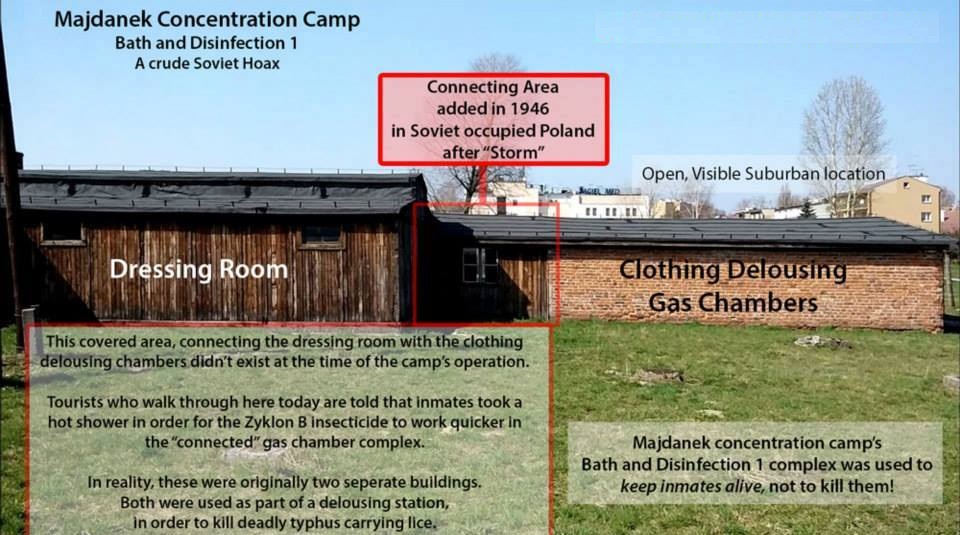Inquiry Confirms Nazi Death Camps
1,715,000 Jews said to have been put to death by the Germans up to April 15
By Daniel T. Brigham
By Telephone to the New York Times
[July 3, 1944] [page 3]
This article article has the distinction of being the first time the word "Auschwitz" ever appeared in the pages of the New York Times, despite the camp existing for over four years by that point, under German authority and under that German name. The word 'Auschwitz' had never appeared, but the camp had made scattered appearances under its Polish name (more on that momentarily).
If you read the July 3 '44 article, you'll see the Auschwitz legend in close to its mature form:
It has elsewhere been reported that the ultimate source of the information in this report is Vrba and Wetzler, two Jewish Auschwitz inmates who escaped in April 1944 and began circulating gassing claims, finding a receptive audience and relishing their instant celebrity. Their sensational claims were passed up anti-Nazi networks' informational chains-of-command until percolating all the way to the pages of the New York Times within a few weeks. But the gassings claims only got space on page 3 and page 5, never page 1, which suggests to me the editors didn't believe them.
(Vrba himself was later at the Zundel Holocaust trial as a witness for the Holocaust Belief side.)
What about its Polish spelling, "Oswiecim"? That made nine appearances in the NYT between June 1941 and June 1944.
One from as late as January 1944 is a book review of The Black Book of Polish Jewry, a book which purported to document the dissolution-and/or-destruction of Polish Jews during the years since the 1939 Germany-Poland war, and which the New York Times headlined "Chapter and Verse of the Nazi Pogrom." The curious thing here is that while it does mention Oswiecim (only in its Polish name), it only says that "tens of thousands" of Jews had been sent there and "destroyed."
Only one article which uses "Oswiecim" and mentions gassings predates the July 3 article, and it only predates it by two weeks:
Czechs Report Massacre
Claim the Nazis Killed 7,000 in Prison Gas Chambers
[June 20, 1944] [page 5]
Who is this "young Pole who had been imprisoned in both camps" who "confirm[ed] the existence of these gas chambers"?
The "report received from inside Europe" I believe also refers to the Vrba and Wetzler report claiming gassings, which they came up with a few weeks earlier.
On June 25, we see another Auschwitz gassing claim appearing in the pages of the New York Times. It specifies that "victims come from all groups," but Jews were given first place:
New Mass Executions in Poland Reported
Victims Come From All Groups, Underground Says
[June 25, 1944] [page 5]
Notice it says 100,000 Jews had been "sent to Auschwitz for execution." By 1946, this would become millions.
Notice also the prominence given to prisoners-of-war among those supposedly being gassed. One thing you notice in anti-Nazi atrocity propaganda closer to the war is how prisoners-of-war were given much more attention than Jews. In our time, no one remembers the Nazis for mistreating or killing prisoners-of-war, only for killing Jews. Plus maybe a handful of miscellaneous groups like Gypsies or Jehovah's Witnesses, but primarily Jews.
___________________
In line with another recent thread (Oswiecim - Camp of Death, 1944 booklet), earlier reports about Auschwitz did not mention Jews at all:
250 Poles Report Dying Daily in Camp
Exiled Government Gives Data on Oswiecim Prison
[March 8, 1943]
Notice the wording of the causes of deaths at Auschwitz/Oswiecim in this March 1943 article: "[E]xecutions, inhuman treatment, hunger and epidemics" (all of which had then, or would have within the next two years, relatively good basis in reality, but the question of scale is debatable). Not only is there no gassing claim being made by this time, Jews are not even mentioned. A characteristic example of the kinds of people being shipped to Auschwitz in this brief March 1943 article are "sixty Polish miners."
This began to change only in summer 1944, as shown above, and then solidified in 1945/6.
___________________
A word on context: Recall what was going on in June and July 1944 when the first NYT Auschwitz gassing claims surface (albeit off the front pages). D-Day had occurred June 6 and the eventual British and American military conquest of Europe up to the Elbe was in motion. But -- at the time these two reports appeared in the New York Times, the whole thing was still stuck in Normandy, awaiting the breakout in August.
With the American-led coalition's military-industrial machine looking unstoppable, the outlines of the future world order were becoming clear, if they had the will to carry on the war until the end. Atrocity claims would be even more useful than usual at this stage, to give the fuel to continue the war and to justify a post-war new order under American leadership. People with a perceived stake in this can be forgiven for running with what was available, all kinds of atrocity stories. The one (of many) that would eventually become the "hegemonic" WWII narrative we see make its first meek appearances in June and July 1944.

